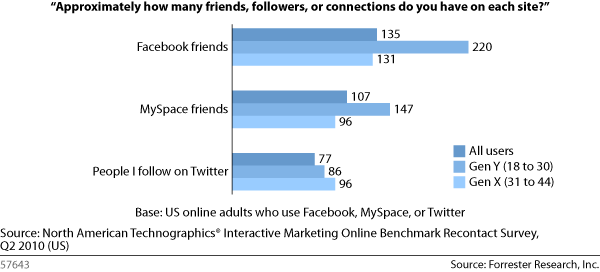Identifying — And Defeating — Social Clutter
Something amazing has happened to social media in the past couple of years: Overall adoption of social technologies has effectively reached saturation. We’re now at the point where more than 80% of US online users engage with social media – and although there’s been some hand-wringing over the fact social media adoption has plateaued at that level, let’s keep things in perspective: 80% engage with social media! That’s as many people as own a DVD player or use SMS.
This kind of scale gives marketers the potential to generate reach through social media. Sure, it’s a new and unfamiliar kind of reach for many marketers – rather than just shouting uniform messages at millions of people, they must engage directly with their audiences and then hope those audiences turn around and talk to and influence millions more users. But as we’ve proven, this new model of reach can also provide the same kind of massive scale that the old reach models did: Just a tiny handful of Mass Connectors will create 256 billion influence impressions in the US this year.
The challenge now is that with big reach and big scale comes a big problem: social clutter. In my new report, Defeating Social Clutter, I report that US online users can average hundreds of friend connections across their social networks – with even higher numbers among younger users – and that in total this means there’s an enormous amount of social content flowing toward audiences today. Despite that huge volume of content – or perhaps because of it – on average, people check their social networking feeds only once every few days. They check into Facebook – where they average the most friends – least frequently of all the major social networks.

With these types of numbers, it’s little surprise that marketers are telling us that the content and messages they’re posting in social networks aren’t necessarily getting through. It’s not a new problem – a year ago I warned marketers that “in busy environments like Facebook and Twitter, the majority of your fans or followers probably won't see your messages” – but it’s one that we’ve been hearing more and more about at Forrester. And our data indicates that the problem is only going to get worse.
So what can marketers do about it? We’d love to hear your thoughts in the comments below – but for now we’ve identified two broad strategies for defeating social clutter:
- Go through the clutter. As a marketer there's only one way sure way cut through this tidal wave of social content: Make sure your messages are coming from a trusted source. And sadly, that source probably isn't you. As social clutter continues to grow, so will the importance of peer influence. So if you're not already actively looking for ways to identify and energize your Mass Mavens and Mass Connectors, now's the time to start. And for goodness sake, give them something genuinely interesting to talk about!
- Go around the clutter. Easier than cutting straight through clutter is finding a way around it – by tapping into what I call "open spaces" in social media. That could mean focusing on audiences for whom clutter is less of a problem, even if they're a secondary audience for your brand; it could mean looking harder for genuinely new content and experiences to offer, rather than spinning off of existing ideas; it could mean focusing on less-popular social networks where you'll find fewer users but have more of their attention – or even starting your own private niche social network to guarantee unfettered access to your audience. Put simply, make sure you're not just following the pack in terms of audiences, ideas, or execution – because the pack is exactly the type of social clutter you're trying to avoid.
Based on this first piece of research into social clutter, we're planning to further analyze our data and build tools to help marketers find ways around the clutter – look for specific tools to help with that problem by the end of the year. Until then, I'd love to hear in the comments below whether social clutter is stopping you from connecting to your users, and what you've been doing about.
UPDATE: I was remiss earlier for not thanking the blog commenters and Forrester Interactive Marketing community members who contributed to a remarkably vibrant discussion on this topic over the summer. That discussion helped me further my thinking on the topic — and I'm grateful for the community's participation in my research.